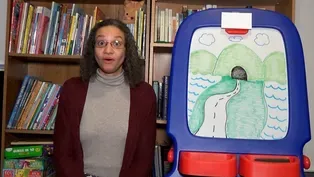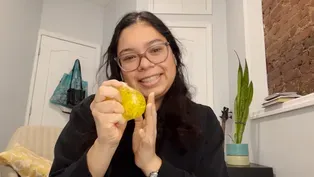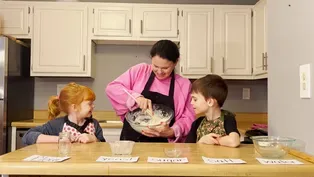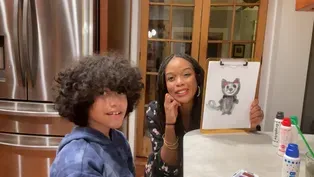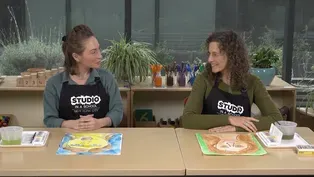
DANCING PATHWAYS
Clip: 5/5/2023 | 9m 9sVideo has Audio Description, Closed Captions
Shawn Bible’s dance students show how to move in straight, curved, and zig-zag pathways.
With his dance students, Shawn Bible explores moving in straight, curved and zig-zag pathways.
See all videos with Audio DescriptionADProblems with Closed Captions? Closed Captioning Feedback
Problems with Closed Captions? Closed Captioning Feedback
Let's Learn is a local public television program presented by THIRTEEN PBS

DANCING PATHWAYS
Clip: 5/5/2023 | 9m 9sVideo has Audio Description, Closed Captions
With his dance students, Shawn Bible explores moving in straight, curved and zig-zag pathways.
See all videos with Audio DescriptionADProblems with Closed Captions? Closed Captioning Feedback
How to Watch Let's Learn
Let's Learn is available to stream on pbs.org and the free PBS App, available on iPhone, Apple TV, Android TV, Android smartphones, Amazon Fire TV, Amazon Fire Tablet, Roku, Samsung Smart TV, and Vizio.
Providing Support for PBS.org
Learn Moreabout PBS online sponsorship[upbeat music] - Hello friends, I'm Shawn Bible, a dance professor at Manhattanville College, and these are my students.
- Hi, I'm Paige.
- Hi, I'm Jessy.
- Hi, I'm Danielle.
- Hi, I'm Lexi.
- Hi everyone, welcome.
Have you been in a dance studio before?
Did you notice what shape our dance studio is?
- [Speaker] Here's a drawing that shows what the dance studio looks like from above.
- That's right, it's a big rectangle because it has four long sides and four square corners.
Did you also notice the mirrors on the walls that the dancers use to look at themselves?
[upbeat music] How about the bars on the ground that the dancers use to hold onto?
A dance studio is a space where dancers come to take class and learn how to move their bodies through space.
- Like outer space?
- Well, not exactly.
There are two kinds of space: Personal space and public space.
Personal space is a space that's very close to you, it's very close to your body.
And if you extend your arms out as far as you can, that's your personal space without moving your feet at all, keeping them grounded.
At school you might talk about your personal space as your bubble space, or staying in your bubble.
- Can you see it?
- No, but you can feel it.
Everyone stand up.
Friends at home, stand up.
Plant your feet on the ground, and don't move, stay there.
And now move your arms and your torso and your head as much as you can in that space without moving your feet.
Maybe it's like a tube, you have to move up and down, and you can't get out, only at the top and at the bottom.
Or you're in a big bubble that you can't get out of, only on the inside, pressing all the walls.
[upbeat music] Great job everyone!
A good time to use your personal space is when you're meeting new people.
[upbeat music] It's always a good idea to have some personal space between the two of you, so that everybody feels comfortable.
[upbeat music] Great job using your personal space, everyone.
In dance, the space beyond your personal space or bubble space is called your public space or your shared space.
[upbeat music] Public space is the space all around your body.
Everywhere you go, wherever you're moving, all the space in the room.
[upbeat music] The dancers are moving in their public space in the dance studio right now.
[upbeat music] Friends at home, join us.
Move around in the public space that you have in the room that you're in.
So let your body move.
Reach beyond, you can move your feet.
Reach towards the walls, reach towards the floor, reach towards the ceiling, reach towards the sky.
[upbeat music] Great job everyone!
Let's play a game.
How about every time I say "personal space", you start moving in your personal space, wherever you are.
And then when I say "shared space", you move in your shared space.
So we'll go from small movements of personal space to big movements of public space.
Are you ready?
[playful music] Here we go.
Personal space.
[playful music] Shared space.
[playful music] Personal space.
[playful music] Shared space.
[playful music] Personal space.
[playful music] Shared space.
[playful music] Great job, everyone!
Fantastic!
One time I was in public space or a shared space, and I noticed everyone moving in different directions.
Those directions are called pathways.
We have three types of pathways.
The first pathway is a straight pathway, the second pathway is a curved pathway, and the third pathway is a zigzag pathway.
This is what a straight pathway looks like from above the dance studio.
Danielle, can you show us moving in a straight pathway?
[upbeat music] Danielle is walking on a tightrope from one point to the other in a perfectly straight line.
Friends at home, can you draw a straight pathway with me with your finger?
Here we go.
Great job!
Some other examples are walking down the stairs, and walking down the aisle.
Friends at home, can you stand up and move from one point to the other in the room that you're in in a straight pathway?
Go.
[playful music] Great job, everyone!
The second type of pathway is a curved pathway, and a curved pathway is an arc, or like walking in a circle.
This is what a curved pathway looks like from above the dance studio.
Jess, can you show us what it's like to move in a circular pathway?
[upbeat music] Great job, Jess!
Really nice walking and moving in a circular pathway.
Friends at home, can you make a circular pathway with me using your fingers?
Here we go.
Wow!
Great job, everyone!
Have you moved in a circular pathway today?
Some other examples of moving in a circular pathway might be... Hmm, can you think of any?
How about walking around a [indistinct] [upbeat music] Or being on a roller coaster?
Or jogging around a track outside?
Those are all great examples of a circular pathway.
Do you wanna move in a circular pathway?
Let's all stand up and walk in a circular pathway around the space that we're in.
Let's make a circle.
[playful music] Great job, everyone!
Fantastic work.
The third type of pathway is a zigzag pathway.
And that pathway connects multiple points together using straight lines.
So it's like a straight pathway connecting multiple points rather than just two.
A straight pathway connects one point to another point, a zigzag pathway connects more points.
- [Speaker] This is what a zigzag pathway looks like from above the dance studio.
- Paige, can you show us what a zigzag pathway looks like?
[playful music] Great job!
Friends at home, can you draw a zigzag pathway with me with your finger?
Great job!
We're connecting multiple points with straight lines.
The three types of pathways that we moved in today are straight lines, curved pathways, and zigzag pathways.
So we talked about a lot of space today.
We talked about our personal space, moving close within our body.
We talked about public space, moving big into this public space, expansive, moving our feet all around the rooms.
And then we talked about the pathways that we move in: A straight pathway, a curved pathway, and a zigzag pathway.
Thank you, everybody.
It's been so great dancing with you.
Thank you so much for joining us in our dance studio.
Bye-bye.
ADDING MAGIC E TO WORDS WITH I
Video has Audio Description, Closed Captions
Clip: 5/5/2023 | 8m 16s | Anna Scretching-Cole explains how e at the end of a word can change the vowel sound of i. (8m 16s)
Video has Audio Description, Closed Captions
Clip: 5/5/2023 | 8m 20s | Introducing Spanish words, Brenda Salazar explains how items from her home represent her. (8m 20s)
Video has Audio Description, Closed Captions
Clip: 5/5/2023 | 34s | Jewel loves to dance. (34s)
Video has Audio Description, Closed Captions
Clip: 5/5/2023 | 10m 7s | Cassondra Easterling and her children show how to make bread. (10m 7s)
Video has Audio Description, Closed Captions
Clip: 5/5/2023 | 10m 20s | Maria Begg-Roberson reads PERFECT PARTNERS by Mary Amato, illustrated by Kashin Kheiriyeh. (10m 20s)
Video has Audio Description, Closed Captions
Clip: 5/5/2023 | 9m 42s | Katherine Huala and Belinda Blum from Studio in a School create self-portraits. (9m 42s)
Providing Support for PBS.org
Learn Moreabout PBS online sponsorshipSupport for PBS provided by:
Let's Learn is a local public television program presented by THIRTEEN PBS
